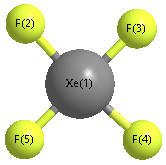Geometric Data

Point Group D4h
Internal coordinates
distances (r) in Å, angles (a) in degrees, dihedrals (d) in degrees
| Description |
Value |
unc. |
Connectivity |
Reference |
Comment |
| Atom 1 |
Atom 2 |
Atom 3 |
Atom 4 |
| rFXe |
1.935 |
0.000 |
1 |
2 |
|
|
1996Bur/Ma:4945-4953 |
r0 |
| aFXeF |
90 |
|
2 |
1 |
3 |
|
|
by symmetry |
| aFXeF |
180 |
|
2 |
1 |
4 |
|
|
by symmetry |
Cartesians
| Atom |
x (Å) |
y (Å) |
z (Å) |
| Xe1 |
0.0000 |
0.0000 |
0.0000 |
| F2 |
0.0000 |
1.9349 |
0.0000 |
| F3 |
1.9349 |
0.0000 |
0.0000 |
| F4 |
0.0000 |
-1.9349 |
0.0000 |
| F5 |
-1.9349 |
0.0000 |
0.0000 |
Atom - Atom Distances 
Distances in Å
| |
Xe1 |
F2 |
F3 |
F4 |
F5 |
| Xe1 |
|
1.9349 | 1.9349 | 1.9349 | 1.9349 |
| F2 |
1.9349 |
|
2.7363 | 3.8697 | 2.7363 |
| F3 |
1.9349 | 2.7363 |
|
2.7363 | 3.8697 |
| F4 |
1.9349 | 3.8697 | 2.7363 |
|
2.7363 |
| F5 |
1.9349 | 2.7363 | 3.8697 | 2.7363 |
|
Calculated geometries
for XeF
4 (Xenon tetrafluoride).
Experimental Bond Angles (degrees) from cartesians 
| atom1 |
atom2 |
atom3 |
angle |
|
atom1 |
atom2 |
atom3 |
angle |
| F2 |
Xe1 |
F3 |
90.000 |
|
F2 |
Xe1 |
F4 |
180.000 |
| F2 |
Xe1 |
F5 |
90.000 |
|
F3 |
Xe1 |
F4 |
90.000 |
| F3 |
Xe1 |
F5 |
180.000 |
|
F4 |
Xe1 |
F5 |
90.000 |
Bond descriptions
Examples: C-C single bond, C=C, double bond, C#C triple bond, C:C aromatic bond
Connectivity
| Atom 1 |
Atom 2 |
| Xe1 |
F2 |
| Xe1 |
F3 |
| Xe1 |
F4 |
| Xe1 |
F5 |








